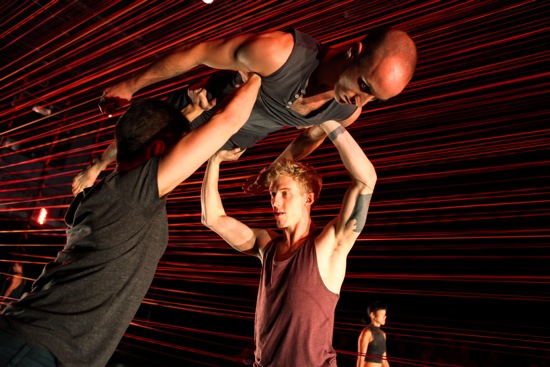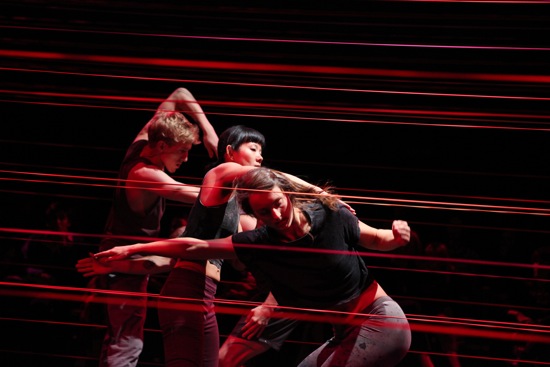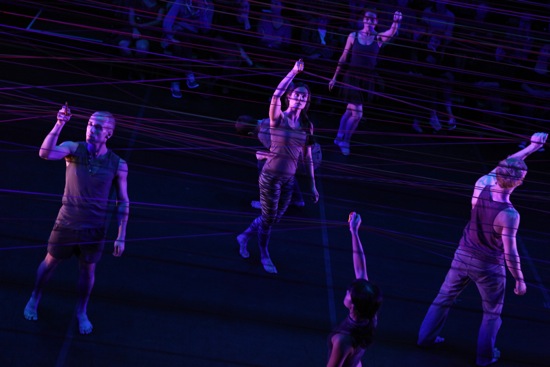David Dorfman and Brian Brooks present new works in two of BAM’s theaters.
Choreographer David Dorfman wears his heart on his sleeve. As his newest work Come, and Back Again shows, it’s a very big heart and an imaginatively tailored sleeve. His past works have tackled political, historical, and social topics, but always in warmly personal ways. He’s not shy about friendship as a topic (especially in his collaborative talking-dancing duets with Dan Froot) and family.
The death of his father, who, as I remember, once made a cameo appearance in a Dorfman dance, may have prompted Come, and Back Again. So, too, may Dorfman’s own aging process; he is 57, and he dances to beat the band in more ways than one. This piece, which premiered on BAM’s main stage, is mostly about moving on, about what you cherish, and about what you leave behind—also about vowing not to leaving a mess for others to clean up. A close-up of Dorfman’s face, projected on a small free-standing structure, explains that his father was very neat while he is not (he, for example, has a massive plastic bag collection stored in his garage). He does, however, pick up the pieces of the structure after demolishing it.
The set installation for the dance both embraces clutter and elevates it into art. I would say that artist Jonah Emerson-Bell’s creation contains everything but the kitchen sink, but I couldn’t swear to that. The stash of town-dump items elegantly assembled on a wall and painted white may well include a sink. Seth Reiser’s lighting turns it different colors. The players that musical director Sam Crawford has assembled sit in front of the structure a little to the side. From where I sit, I can’t see guitarist Zeb Gould, horn player Anthony Mascorro, or percussionist Timothy Quigley, but Aaron Diskin (the principal vocalist), singer Liz de Lise, and cellist Christopher Lancaster are on view. Almost all of the songs they play are from the repertory of the defunct 1990s band, Smoke (at least one is by Patti Smith, for whom Smoke once opened), and they are raw and terrific. Channeling the band’s leader, Benjamin, who enjoyed cross-dressing, Crawford wears a corset and shabby petticoat.
Dorfman and his four dancers are flying bundles of energy. Raja Kelly, Kendra Portier, Karl Rogers, and Whitney Ripplemeyer-Tucker are all adroit at Dorfman’s leaping, kicking, spinning, skipping, tumbling movement style. The choreographer himself is masterful at shaping it, so that he seems to explode in an exultant fury of resilient movement, but every now and then pauses or slows down as if to assess what he’s doing and tame his breath before he throws himself into dancing again. Fierceness enters the emotional arena too. Ripplmeyer-Tucker attacks Kelly, knocking him down over and over by batting his outstretched arm, and then really having at him.
In this very personal dance, Dorfman’s 12-year-old son, Samson Race Dorfman, hurtles through a bout of wild-limbed dancing that may remind Dorfman père of his own younger days. At another point, a door in the set opens, and in comes the wonderful Lisa Race, Dorfman’s wife. Her ebullient, playful dancing, while he admiringly plays an accordion, is one of the evening’s high spots. Amid the objects on the “wall,” Callie Curry aka Swoon has embedded skewed black-and-white film images of the city; these appear intermittently, along with film clips of a younger David Dorfman.
Words figure prominently in Come, and Back Again. Ripplemeyer-Tucker, as a filmed talking head, presents the game of life in terms of wacky points gained and lost (e.g. “If you are 23 or younger, start over” and “Subtract 90 if your husband slept with your best friend”). The performers pun on the usual, ambiguous terms for death. “When would you go?” asks Portier of Kelly, as they hold each other at arm’s length. Then they sit down and hug. “I wouldn’t mind dying,” says Dorfman, but I gotta go by myself.” Several times, his four dancers gravely wave goodbye to him, and he waves to his younger image. The others also echo his dancing, as if they wanted to remember him by it. The almost matter-of-fact way that Dorfman and the other performers approach these moments keeps them from falling into sentimentality.
Love creates a glow, along with Reiser’s lighting. Unexpectedly, the musicians leave their chairs and walk out to meet dancer-partners. Embraced, the pairs slow-dance in place, until Crawford has to go sit back down and sing more songs of love and loss. And there are many images of people helping others—say to jump higher. There’s a late reprise of the numbers game (“Start with the number of people you’ve seen take their final breath”), while the music pushes a strong rock beat forward.
After all the hurly-burly, the questions, the encounters—both seen and heard—Come, and Back Again condenses into a phone message that Dorfman is leaving for Race, The show went well, he says. His final words, “I promise to clean up my mess.”
Come, and Back Again is sort of messy, but isn’t love? Isn’t life? I don’t mind being reminded of that rich confusion.

Jeff Sykes (L) and Bryan Strimpel lift Matthew Albert in Brian Brooks’s Run Don’t Run. Photo: Julieta Cervantes
The title of Brian Brooks’s Run Don’t Run has a certain semantic connection to Dorfman’s title, and it also premiered a week later at BAM, in the intimate Fishman Space up the street. Brook’s composer, Christopher Lancaster played cello for Dorfman. There any comparison ends. Brooks is the tidiest of choreographers, setting up a tension between immaculately designed, highly repetitive structures and strong, athletic movement. The longer his dances—or actions within them—go on, the more evocative of human experience they become.
The audience for Run Don’t Run is positioned in rows along the black-box theater’s two long walls and on the balconies above these. Brooks and Philip Treviño have filled the space between them with five fences, made of horizontal strands of red rope. These traverse the length of the room and reach from the floor to high above our heads. While we wait for the piece to start, we can watch the opposite bank of spectators striped in red. Joe Levasseur’s lighting sets the ropes on fire.
The eight dancers, then, inhabit a channeled world. New York traffic comes to mind. Their principal direction is from the audience’s right to its left, or vice versa. At first, it’s like being in a railroad yard to watch them—or it would be if they weren’t moving with such slow deliberation. Walk, jump-turn, walk. They can, however, change tracks by ducking under and stepping over the cords. And Brooks has numerous variations to develop.
Two of the men lift Matthew Albert straight up between them, leaning in to do so; he hangs there like a doll. Then they put him down and slide his feet along the floor, so they can move on and do it again. Two of the women lift Jo-anne Lee the same way. Often Brooks repeats a move like this a number of times, and then surprises you by having one or more dancers change it slightly.
Lancaster’s music supports the atmosphere admirably—beginning with a ringing tone over a sustained throb, pausing, introducing a spare melody. After a while I begin to view the dancers both as themselves (Albert, Lee, Carlye Eckert, Meghan Frederick, Haylee Nichele, Bryan Strimpel, Jeff Sykes, and Evan Teitelbaum) and a busy community, like a colony of ants, whose habits are evident, but whose motives are often mysterious. What, I wonder, constitutes a development? And what would a rebellion look like? Meanwhile they lie down, prone or supine. They kneel and stare into the distance. They do something and walk on. They run. The same actions may take different lengths of time.

L to R: Bryan Strimpel, Jo-anne Lee, and Meghan Frederick in Run Don’t Run. Photo: Julieta Cervantes
When some of them sit in a relaxed manner and face a diagonal, instead of facing one bank of spectators or the other, the change seems momentous, especially when the performers hold down some of the lower ropes, which then vibrate when released. When they sit or recline while holding down several strands, their obviously transient power is suspenseful—a finger in the dyke kind of moment. When they lean a little into one of the ropes, the elasticity becomes another facet: fences can yield.
These resourceful workers can also adjust their environment. With the workaday demeanor of employees in a railroad yard supervising the coupling of cars, they gather cords and clip them together. This maneuver results in the illusion of red rays of light; it also enlarges the space for dancing or alters it in other ways). Teitelbaum and Frederick dance together in the middle space—lunging, turning, gesturing. Various of the activities co-exist different channels. A new move surfaces: two people, facing one another wrestle air, in a close dance of non-connecting curves. Eckert dances alone amid vibrating ropes.

Brian Brooks’s Run Don’t Run. (L to R): Matthew Albert, Haylee Nichele, Jo-anne Lee (foreground), Carlye Eckert, Bryan Strimpel. Photo: Julieta Cervantes
The clips are taken off, then put on again differently. The atmosphere turn blue. Spotlights low to the floor beam out. The music becomes eerie. Brooks is building contrast. Sometimes several performers present different patterns simultaneously. The visual design and the music thicken, then drain into simplicity. Even when the ropes are bound, the dancers make ducking under a part of the movement vocabulary. The more they do, the more they want to do. Suddenly everyone knows how to jut his or her elbows out like little wings (Frederick started that, and it has caught on).
Toward the end of the hour-long piece, when the dancers are crawl-walking down the restored aisles, Lancaster blasts them with some crazy rock music energy. As the sounds rave on, some of the eight move in a squat, bending far back under the aural wildness. But the music fades, the lighting cools down, and the performers prune back what they have grown, until they’re walking, sitting, lying, rolling, and leaning lightly against the waist-high ropes.
One of the things that makes Run Don’t Run fascinating is the ways in which Brooks mingles routine and fantasy so imaginatively. The worker-dancers find ways to make their terrain more flexible, more productive—all the time acknowledging its constraints. I feel a metaphor coming on.






I am regular visitor, how are you everybody?
This piece of writing posted at this web page
is actually good.